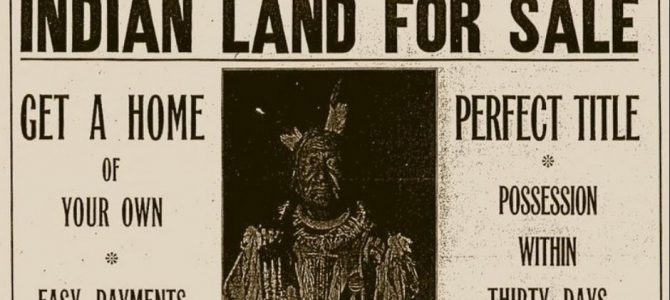
As a child, my interaction with American Indians was limited to gazing at billboards for casinos along the highways of my home state, Wisconsin. The neon lights and ads for fading rock acts confused me. When I thought of Indians, I thought about forests. Deer. Streams. Moccasins. Not gambling or all-you-can-eat buffets designed to keep people inside, in the dark, as long as possible. Yet there they were. Even as a child who didn’t much understand the depths of despair that surround gambling, I still felt it emanating from those shiny lights.
My husband grew up in Indian country: Montana. Casinos dot that landscape, too. A few blocks down from his parents’ home is a boring-looking, garish little casino with a cartoonish mascot, called Montana Lil’s. On the front pages of local newspapers almost every day when we visited this summer was news about a Crow woman, Roylynn Rides Horse, who in April was strangled, beaten, doused with gasoline, and burned almost to death. The FBI says the “victim suffered third degree burns over 45 percent of her body and severe frostbite on her legs” and was left in a field to die until she was discovered 14 hours later.
Of the six alleged perpetrators, the two apparent leaders were also Indians—one is Crow and another Northern Cheyenne. During an initial hearing their federal defenders told the court the two, who are ages 18 and 23, “had no jobs or income or bills and lived with their mothers.” They allegedly dragged Rides Horse out of a car during an argument after leaving a bar together.
The witnesses “could not or would not tell investigators who doused R.R. [Rides Horse] with gasoline and who set R.R. on fire, but it was either Sanchez or Whiteman or both,” the Billings Gazette quoted from court records. It’s grisly stuff. And not atypical for Indian reservations, as Naomi Riley shows in her new book about America’s Third World ghettoes, “The New Trail of Tears: How Washington Is Destroying American Indians.”
It’s a slim volume, filled with suffering. Riley brings an even tone to a subject filled with pathos. That doesn’t mean she shies away from reality, like most lawmakers and reporters. Yet her interviewees often do—even those who live among the terrible conditions on most Indian reservations.
One of the things they repeatedly say is a variation on “But these are conversations people aren’t willing to have yet,” a line Riley quotes from Keith Moore, a former director of the Bureau of Indian Education. After reading her book, one wonders: How many more people have to be beaten, raped, and burned before their communities are ready to talk about why?
Start with Serf-Level Property Rights
Of course one can’t boil systemic violence down to a tidy list of causes. But it’s possible to tease out major contributing factors, as Riley does, to the almost incomprehensibly horrific conditions Americans allow fellow citizens to live in on Indian reservations. Indians don’t suffer particularly because they need more money or government programs to funnel them money—at just the federal level American taxpayers spend $8 billion per year for Native American-specific programs such as schools, housing subsidies, and medical care. Instead, Riley posits, a major contributor is their lack of a something mundane that most Americans take for granted: property rights.
While the U.S. government insists it respects “tribal self-determination,” in typical government doublespeak this actually means the opposite. To the federal government, tribal self-determination means stripping Indians of property ownership, a major source of self-determination.
Court rulings and laws insist Indian territories are somewhat akin to foreign nations even though Indians are all fully American citizens. This is why reservations do not enforce many U.S. laws and have separate legal systems—a major source of corruption and abject miscarriages of justice such as endemic child rapes and abuse, Riley shows.
Also in the name of tribal sovereignty, the federal government holds 55 million acres in Indian lands “in trust” for tribes. Effectively, this means neither Indians nor the federal government can do a damned thing with the land. So much for “sovereignty.” Why is this important? As Riley explains, land is a key source of precious capital. It’s a resource people use to generate money and economic and social infrastructure.
At a Crow reservation in remote southeastern Montana, for example, “almost no one…can afford to build a home, because no one can get a mortgage,” Riley writes. That’s because “no bank could ever foreclose on a property, because the bank can’t own reservation land.”
Crows and Northern Cheyennes sit on some of the largest oil, gas, and coal reservations in the country,” Riley writes. To tap into those reserves, however, Indians “must follow a 49-step process [!]. These steps involve the Bureau of Land Management, the Department of Interior, the Department of Justice, and the Commerce Department…And it can take months, if not years, for each step to be approved.”
Pack in Some Bureaucratic Sludge
Just to dig a hole requires paying $6,500 upfront merely for a permit, Riley writes. Off the reservation, it takes about $125 and 15 minutes to get the permit, which is approved in a simple five-step process. Why would any company bring jobs, housing, or any other such infrastructure to a reservation, even if it could, when they could spend millions and decades on compliance to end up with nothing?
They wouldn’t. Only concerted efforts over many years by a few tribes themselves have yielded a few limited successes. That’s one big reason reservations are wastelands of casinos and shacks with rusted-out cars parked in yards. “You don’t need to travel to Beijing to see central planning at work,” Riley writes. “It’s everywhere on reservations.” As always, because of this kind of misplaced paternalism, it’s the needy who suffer most, and desperately.
Now imagine transplanting a process like the hole-digging permit into an attempt to get justice for a child who has been molested. Besides such suffocating jurisdiction and interagency bureaucratic sludge, there’s racial and other politics. Federal statistics say one in three Native American women will be raped in her lifetime. In cases reported on Indian lands, 85 percent of victims reported their attackers were Native Americans. Child rape and abuse is also at horrifyingly high rates. A vivid proof of this on the Pine Ridge reservation in South Dakota is the reservation school’s once-monthly “lock-in.”
It’s when children stay at school all weekend for safety. Although the weekend is billed as a cultural enrichment event for the children—they sing songs and play traditional games in the school’s gym—Phelps tells me that it’s timed to coincide when the government checks go out. These are the times when parents are most likely to drink and become abusive, she offers matter-of-factly .
Abusers often get away with their crimes because tribal courts have lower standards than state courts and tribal judges are often related to the families involved. Many tribes do not publish their laws, and do not have rules for discovering and evaluating evidence.
Federal and other officials were reticent to talk to Riley about this, and even to show her crime reports, because “there’s so much guilt about racism, about what was done in the past, that they don’t want to shine a light on crimes taking place now.” Yet again, talk about “sovereignty” offers a convenient politically correct cover to hide endemic rape, child abuse, high rates of drug trafficking and abuse, and Third World-level poverty.
Small Points of Light
Riley also documents small points of light in the darkness. In fact, amid the depressing pictures and statistics it’s clear she’s worked hard to find individuals who are giving their lives to serve the those in need on American Indian reservations. This recent mini-documentary offers a similar flavor in finding folks willing to do the hard work to bring water into a desert. American Indians need more of this, faster.
Since Washington is a major cause of Indian suffering—a Crow legislator told Riley “We are the highest regulated race in the world”—the logical thing to suggest is that it simply get out of the way. Riley gives some basic recommendations about necessary steps, including restoring private property rights, expanding good schools on reservations, granting Indians access to U.S. courts—in other words, extending to Native Americans the same rights and responsibilities as we give all Americans, and which contribute to our country’s stability and success.
Yet it is easier said than done, no matter how much it would benefit American Indians. Washington simply doesn’t care about doing much for Native Americans besides offering them platitudes that, at best, make their situations worse. As Chris Edwards notes on Cato’s blog, “The problem is that Washington is a massive screw-up these days in so many ways. There is so much to repeal and reform, but members of Congress don’t seem to have the time, patience, or incentive to fix the failures that they have created, including the failures of Indian policies.”
Rather than waiting for Washington to set them free, Indians should take their futures into their own hands. Many already have. Two-thirds of Indians do not live on reservations, and those that do not see much better outcomes than those who remain. If we’ve learned anything from more than 200 years of Congress’s interactions with Indians, it’s that, like everyone seeking a better life, Indians have no choice but to look to themselves, not politicians, for hope and success.









